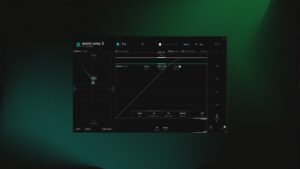When we open a virtual synth or effect, we rarely think about who shaped the interface before us—the balance between function and feeling, the invisible design choices that decide whether we lose ourselves in sound or get lost in confusion.
For Nataliia Hera, co-founder of Voger Design, these invisible layers are the real canvas. Her studio has defined how countless musicians experience music technology. Yet beneath the polished surfaces lies a deeply human philosophy about creation, collaboration, and purpose.
The world that shapes design
Nataliia grew up in central Ukraine, surrounded by abandoned factories and the residue of a vanished system. “When there’s nothing great about your surroundings,” she said, “you go into an imaginary world.”
That instinct—to build worlds inside when the outside fails—became her first design lesson. Aesthetic sensitivity isn’t born from comfort; it’s often forged from emptiness. The imagination becomes an act of survival.
Later, when she and her husband began designing audio interfaces, that same sense of rebuilding carried through. Each layout, texture, and curve was a way of giving order and beauty to chaos. “Skyscrapers aren’t built by solo people,” she said. “They’re built by teams, processes, and standards.” Creativity, she learned, thrives when anchored in structure.
Building the invisible bridge
Voger Design began with almost nothing—“eighty dollars in my pocket,” as she put it—but with an abundance of curiosity. Their early work for Reaper themes and small developers turned heads because it made software feel musical. The secret wasn’t flashy visuals; it was empathy.
An interface, Nataliia believes, is a form of translation—a bridge between the developer’s logic and the musician’s intuition. “Our idea is friendly and yet expensive-looking audio user interfaces—professional, but human.”
That phrase captures the paradox of good design in music tech: it must be clear enough for efficiency, yet inspiring enough to disappear. The best interfaces don’t scream design—they breathe it.
“Professionals still know a lot of things to make great stuff. But empathy is what lets the interface sing.”
The psychology of beauty
Every musician knows the argument: Sound matters, not looks. Nataliia disagrees.
“People who say looks don’t matter are lying to themselves,” she said. “Our decisions are primarily irrational. We buy and use things that make us feel familiar, inspired, or capable.”
The eye is part of the ear. A well-balanced layout lowers anxiety, directs attention, and keeps the creative mind in flow. “The more you use something,” she added, “the more you grow attached to its look and behavior.” Design, in this sense, is not surface—it’s habit made visible.
UI design for music is therefore a psychological act. It’s about shaping perception, not decoration. When done right, the interface becomes invisible, allowing sound to take the foreground while guiding the subconscious through rhythm, hierarchy, and contrast.
Collaboration as the highest art
Hera’s philosophy extends far beyond screens. Collaboration, she insists, is what turns creative energy into lasting architecture.
“Skyscrapers aren’t built by solo designers,” she repeats like a mantra. Her success with Voger was possible because she and her husband divided their strengths—one handling aesthetics and art direction, the other business structure and client communication.
This separation of roles isn’t limitation—it’s liberation. When individuals honor their strengths, collective creativity flourishes. In her words: “Any career is like entrepreneurship. You must perform every function until you can share it with someone who does it better.”
“You need people whose strengths are your weaknesses.”
Designing for humans, not markets
In the saturated world of plugins, it’s easy for developers to chase novelty or trends. Hera’s warning is gentle but pointed: without empathy, technology becomes noise.
She’s seen products fail not because of bad code, but because of ego—creators unwilling to receive feedback, stuck in what she calls an “ideology bubble.” True innovation, she argues, happens in conflict, when different perspectives collide and refine one another.
“The ideas you dislike most,” she said, “are often where you grow.”
For developers, this is the quiet moral of her story: design isn’t a solo statement—it’s a conversation. Listen long enough, and the interface will tell you what it needs to become.
Time, legacy, and the creative balance
As a mother and entrepreneur, Hera now measures design in units of time. “Time is the most precious thing we have,” she told me. Between her son and her company, every decision is a trade of attention. She buys time by outsourcing chores, so she can invest what remains into creation.
“Business and child are both babies,” she laughed. “But one of them can eventually walk on its own.”
Her insight reaches beyond motherhood. Every creative life, whether developer, artist, or musician, is a balancing act between what we build and what we nurture. The search for equilibrium is endless, yet the act itself—the constant adjustment—is what keeps us alive as creators.
Toward a more human future of music tech
In an era when AI threatens to automate creativity, Hera remains quietly optimistic. Machines may simplify production, but meaning still depends on the human hand—and the human interface.
UI design, she reminds us, isn’t a cosmetic afterthought; it’s the humanity layer in technology. It’s where empathy, intuition, and beauty meet logic.
“Design is how we speak to the user’s subconscious. It’s not what we show—it’s what we let them feel.”
Her story is a mirror for anyone working at the intersection of art and engineering. Whether you’re coding DSP algorithms or choosing a new synth to make music with, remember: design is never neutral. Every pixel, every curve, every decision is a philosophy made visible.
🎧 Prefer video or audio?
You can watch (or listen to) the full conversation here:
🔴 Youtube: https://youtu.be/XZWkTwj2TBo
🟢 Spotify: https://open.spotify.com/episode/51pi5iSETGfd2Q28CWDvFV?si=EeuaJrn-QtGqut6wACtJaA
🟣 Apple Podcasts: https://podcasts.apple.com/ca/podcast/philosophy-of-ui-design-in-music-technology-nataliia/id1528017679?i=1000732799998





